| Revision as of 03:19, 10 May 2016 editTomruen (talk | contribs)Autopatrolled, Extended confirmed users, Pending changes reviewers119,883 edits →Past and future transits← Previous edit | Revision as of 10:24, 10 May 2016 edit undo70.196.130.26 (talk) →ReferencesNext edit → | ||
| Line 147: | Line 147: | ||
| * ] | * ] | ||
| <ref>{{cite web|last1=Horton|first1=Adam|title=NASA's Solar Dynamics Laboratory captured closeup of Mercury's transit|url=https://www.youtube.com/watch?v=EsL_8sEqCTI|website=Space Central|accessdate=5-11-2016}}</ref>== References == | |||
| == References == | |||
| *Cunningham, Clifford J., "Mercury's Time to Shine," ''Mercury'' Sep–Oct 2006. | *Cunningham, Clifford J., "Mercury's Time to Shine," ''Mercury'' Sep–Oct 2006. | ||
| <br> | <br> | ||
Revision as of 10:24, 10 May 2016
This article is about the astronomical phenomenon on Earth. For other uses, see Transit of Mercury (disambiguation).| This article documents a current event. Information may change rapidly as the event progresses, and initial news reports may be unreliable. The latest updates to this article may not reflect the most current information. Feel free to improve this article or discuss changes on the talk page, but please note that updates without valid and reliable references will be removed. (May 2016) (Learn how and when to remove this message) |


A transit of Mercury across the Sun takes place when the planet Mercury comes between the Sun and the Earth, and Mercury is seen as a small black dot moving across the face of the Sun.
Transits of Mercury with respect to Earth are much more frequent than transits of Venus, with about 13 or 14 per century, in part because Mercury is closer to the Sun and orbits it more rapidly.
Transits of Mercury occur in May or November. The last four transits occurred in 1999, 2003, 2006, and May 9, 2016. The next will occur on November 11, 2019, and then on November 13, 2032.
On June 3, 2014, the Mars rover Curiosity observed the planet Mercury transiting the Sun, marking the first time a planetary transit has been observed from a celestial body besides Earth.
Occurrence of transits

Transits of Mercury can happen in May or November with May transits being about half as frequent as November transits. They currently occur within a few days either side of May 8 and November 10. The interval between one November transit and the next November transit may be 7, 13, or 33 years; the interval between one May transit and the next May transit may be 13 or 33 years. May transits are less frequent than November transits because during a May transit, Mercury is near aphelion whereas during a November transit, it is near perihelion. Perihelion transits occur more frequently due to two effects: firstly, Mercury moves faster in its orbit at perihelion and can reach the transit node more quickly, and secondly at perihelion Mercury is closer to the Sun and so has less parallax.
During May transits Mercury has an angular diameter of 12" and these transits take place at the descending node of Mercury's orbit. During November transits Mercury has an angular diameter of 10" and these transits occur at the ascending node.
Transits of Mercury are gradually drifting later in the year; before 1585 they occurred in April and October.
Grazing transits of Mercury

Sometimes Mercury appears to only graze the Sun during a transit. In this case it is possible that in some areas of the Earth a full transit can be seen while in other regions there is only a partial transit (no second or third contact). The transit of November 15, 1999 was such a transit, and the previous one before that was on October 28, 743. The next such transit will occur on May 11, 2391.
It is also possible that a transit of Mercury can be seen in some parts of the world as a partial transit, while in others Mercury misses the Sun. Such a transit last occurred on May 11, 1937, and the previous one was on October 21, 1342. The next such transit will occur on May 13, 2608.
Past and future transits
The first observation of a transit of Mercury was on November 7, 1631 by Pierre Gassendi. Johannes Kepler had however predicted the occurrence of transits of Mercury and Venus some time before that. Gassendi unsuccessfully attempted to observe the transit of Venus just one month later, but due to inaccurate astronomical tables he did not realize that it was not visible from most of Europe, including Paris. A transit of Venus was not observed until 1639, by Jeremiah Horrocks. The table below does not include all historical transits of Mercury.
| Past transits of Mercury | |||||
|---|---|---|---|---|---|
| Date of mid-transit |
Time (UTC) | Notes | |||
| Start | Mid | End | |||
| 1631 Nov 7 | Observed by Pierre Gassendi. | ||||
| 1651 Nov 3 | Observed by Jeremy Shakerly in Surat, reported in letter to Henry Osbourne, January 1652. Shakerly is thought to have died in India around 1655. | ||||
| 1661 May 3 | Occurred on the day of the coronation of King Charles II of England. Observed by Christiaan Huygens in London. | ||||
| 1677 Nov 7 | Observed by Edmund Halley in St Helena and Richard Towneley in Lancashire to determine solar parallax, also noted by Jean Charles Gallet in Avignon; as reported in letter from John Flamsteed to Johannes Hevelius 23 May 1678 | ||||
| 1743 Nov 5 | Coordinated scientific observations were organized by Joseph-Nicolas Delisle worldwide. | ||||
| 1753 May 6 | |||||
| 1769 Nov 9 | 23:09 | Observed by Charles Green and James Cook from Mercury Bay in New Zealand. Noted that Mercury had little or no atmosphere. | |||
| 1802 Nov 9 | 06:16 | 08:58 | 11:41 | Observed by William Herschel in England | |
| 1815 Nov 12 | 00:20 | 02:33 | 04:46 | ||
| 1822 Nov 5 | 01:04 | 02:25 | 03:45 | ||
| 1832 May 5 | 09:04 | 12:25 | 15:47 | ||
| 1835 Nov 7 | 17:35 | 20:08 | 22:41 | ||
| 1845 May 8 | 16:24 | 19:37 | 22:49 | ||
| 1848 Nov 9 | 11:07 | 13:48 | 16:28 | ||
| 1861 Nov 12 | 05:21 | 07:19 | 09:18 | ||
| 1868 Nov 5 | 05:28 | 07:14 | 09:00 | ||
| 1878 May 6 | 15:16 | 19:00 | 22:44 | ||
| 1881 Nov 6-7 | 22:19 | 00:57 | 03:36 | ||
| 1891 May 8-9 | 23:57 | 02:22 | 04:47 | ||
| 1894 Nov 10 | 15:58 | 18:35 | 21:11 | ||
| 1907 Nov 14 | 10:24 | 12:07 | 13:50 | ||
| 1914 Nov 7 | 09:57 | 12:03 | 14:09 | ||
| 1924 May 8-9 | 21:44 | 01:41 | 05:38 | ||
| 1927 Nov 10 | 03:02 | 05:46 | 08:29 | ||
| 1937 May 11 | 08:53 | 08:59 | 09:06 | Only visible as partial transit in Southern Africa, Southern Arabia, South Asia and Western Australia. | |
| 1940 Nov 11-12 | 20:49 | 23:21 | 01:53 | ||
| 1953 Nov 14 | 15:37 | 16:54 | 18:11 | ||
| 1957 May 5-6 | 23:59 | 01:14 | 02:30 | ||
| 1960 Nov 7 | 14:34 | 16:53 | 19:12 | ||
| 1970 May 9 | 04:19 | 08:16 | 12:13 | ||
| 1973 Nov 10 | 07:47 | 10:32 | 13:17 | ||
| 1986 Nov 13 | 01:43 | 04:07 | 06:31 | ||
| 1993 Nov 6 | 03:06 | 03:57 | 04:47 | ||
1999 Nov 15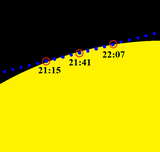 |
21:15 | 21:41 | 22:07 | Partial transit in Australia, Antarctica and New Zealand's South Island | |
| 2003 May 7 | 05:13 | 07:52 | 10:32 | ||
2006 Nov 8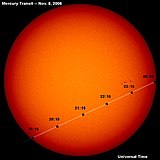 |
18:12 | 20:41 | 23:10 | ||
2016 May 9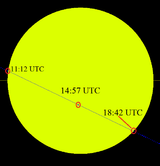 |
11:12 | 14:57 | 18:42 | entire transit in S. America, eastern N. America, western Europe; part of transit everywhere else except Australia and far eastern Asia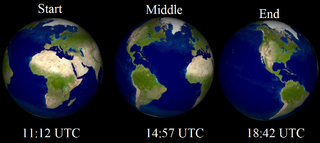
| |
| Future transits of Mercury | |||||
|---|---|---|---|---|---|
| Date of mid-transit |
Time (UTC) | Notes | |||
| Start | Mid | End | |||
2019 Nov 11 |
12:35 | 15:20 | 18:04 | 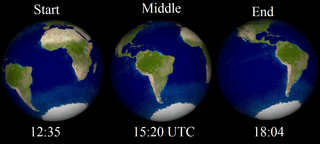
| |
| 2032 Nov 13 | 06:41 | 08:54 | 11:07 | ||
| 2039 Nov 7 | 07:17 | 08:46 | 10:15 | ||
| 2049 May 7 | 11:03 | 14:24 | 17:44 | ||
| 2052 Nov 8-9 | 22:53 | 01:29 | 04:06 | ||
| 2062 May 10-11 | 18:16 | 21:36 | 01:00 | ||
| 2065 Nov 11-12 | 19:24 | 22:06 | 01:48 | ||
| 2078 Nov 14 | 11:42 | 13:41 | 15:39 | ||
| 2085 Nov 7 | 11:42 | 13:34 | 15:26 | ||
| 2095 May 8-9 | 17:20 | 21:05 | 00:50 | ||
| 2098 Nov 10 | 04:35 | 07:16 | 09:57 | ||
| 2108 May 12 | 01:40 | 04:16 | 06:52 | ||
See also
== References ==
- Cunningham, Clifford J., "Mercury's Time to Shine," Mercury Sep–Oct 2006.
- ^ Webster, Guy (June 10, 2014). "Mercury Passes in Front of the Sun, as Seen From Mars". NASA. Retrieved June 10, 2014.
- ^ "Seven Century Catalog of Mercury Transits: 1601 CE to 2300 CE". Retrieved 2012-01-11.
During the seven century period 1601 CE to 2300 CE, Earth experiences 94 transits of Mercury across the Sun. These events can be organized into two groups: ... May (Descending Node) = 31 = 33.0% November (Ascending Node) = 63 = 67.0%
- ^ Espenak, Fred. "2003 Transit of Mercury". Retrieved 2012-01-11.
- "1999 Transit of Mercury". nasa.gov. Retrieved 25 August 2015.
- "The November 15, 1999 Transit of Mercury". astroleague.org. Retrieved 25 August 2015.
- Chapman, A. (1985), Transactions of the Historical Society of Lancashire and Cheshire Volume 135 pp 1–14
- Eric G. Forbes et al. (1995), Correspondence of John Flamsteed Volume 1, Institute of Physics Publishing, p. 624-627
- Wayne Orchiston 1994, James Cook and the 1769 Transit OF Mercury, Carter Observatory ISSN 1173-7263 http://www.transitofvenus.co.nz/docs/CarterObservatoryInfo3.doc
- Magazine of Popular Science, and Journal of the Useful Arts, Volume 3 p.154
- "1960 Transit of Mercury". HM Nautical Almanac Office. UK Hydrographic Office. November 5, 2007. Retrieved May 30, 2012.
- "1970 Transit of Mercury". HM Nautical Almanac Office. UK Hydrographic Office. November 5, 2007. Retrieved May 30, 2012.
- "1973 Transit of Mercury". HM Nautical Almanac Office. UK Hydrographic Office. November 5, 2007. Retrieved May 30, 2012.
- "1986 Transit of Mercury". HM Nautical Almanac Office. UK Hydrographic Office. November 5, 2007. Retrieved May 30, 2012.
- "1993 Transit of Mercury". HM Nautical Almanac Office. UK Hydrographic Office. November 5, 2007. Retrieved May 30, 2012.
- "1999 Transit of Mercury". HM Nautical Almanac Office. UK Hydrographic Office. November 5, 2007. Retrieved May 30, 2012.
- "2003 Transit of Mercury". HM Nautical Almanac Office. UK Hydrographic Office. November 5, 2007. Retrieved May 30, 2012.
- "2006 Transit of Mercury". HM Nautical Almanac Office. UK Hydrographic Office. November 5, 2007. Retrieved May 30, 2012.
- "The Transit of Mercury on 2016 May 9". Retrieved June 7, 2012.
- Horton, Adam. "NASA's Solar Dynamics Laboratory captured closeup of Mercury's transit". Space Central. Retrieved 5-11-2016.
{{cite web}}: Check date values in:|accessdate=(help)
External links
- NASA: Transits of Mercury, Seven Century Catalog: 1601 CE to 2300 CE
- NASA: Image from the transit of Mercury in 2003
- Shadow & Substance.com: Transit of Mercury Animated for November 8, 2006
- Transits of Mercury – Fourteen century catalog: 1 601 AD – 3 000 AD
- Transits of Mercury on Earth – Fifteen millennium catalog: 5 000 BC – 10 000 AD
Template:Transit visibility table
Categories: